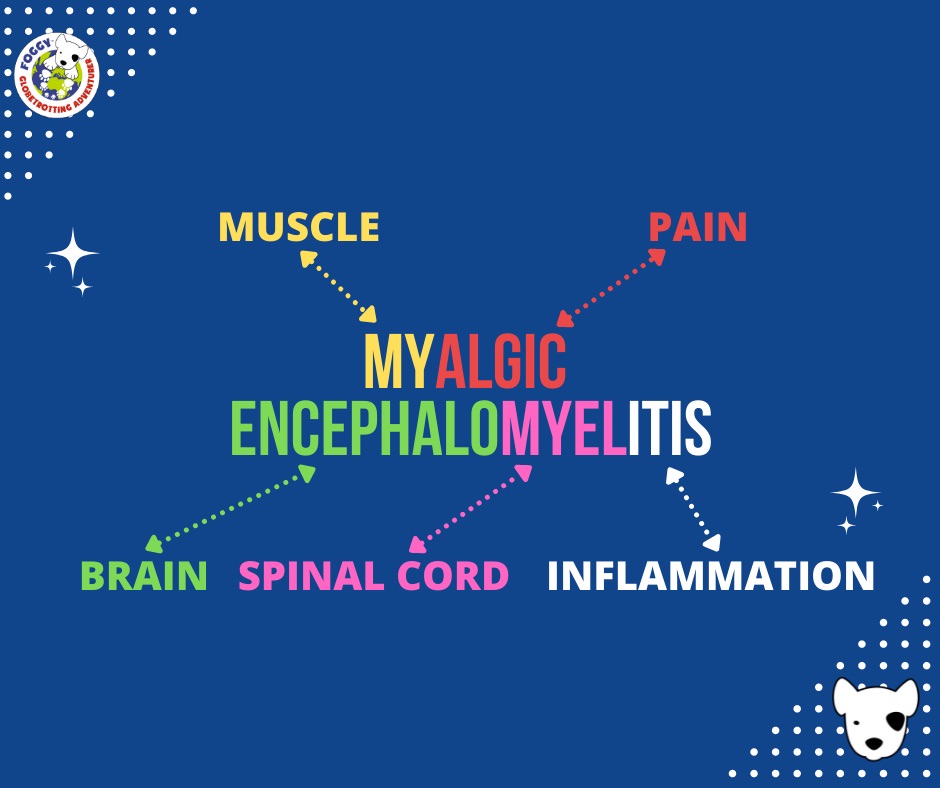Myalgic Encephalomyelitis is a seriously debilitating neurological condition that affects a minimum of 250,000 people in the UK and 17-30 million people worldwide.
M.E. patients not only have to deal with their poor health but also with the political, social and economic issues that come along and play too!
Many medical professionals have been slow to recognise the illness as valid and that has caused so much harm to the patient community.
Great work is being done by researchers and scientists around the globe to establish what causes M.E., discover diagnostic tests, and develop treatments for the disease but M.E. research is massively underfunded by Governments worldwide and so it is taking a long time for progress to be made.
Momentum is building though and, paws crossed, exciting developments will be made soon.
There are NO effective treatments for M.E.
There are pills and potions for each individual symptom but not for the actual M.E. itself. Psychiatrists would have us, and importantly you, believe that it is all in our heads and so can be treated with therapy and exercise. This has caused the M.E. community so much distress and harm. The core feature of M.E. is that increased exertion (physical, mental, emotional) exacerbates our symptoms. Even climbing up one flight of stairs can make some sufferers bed-bound for days, if not weeks. So, to suggest that we can get better through increasing our activity is absurd and extremely harmful to M.E. patients.
There isn’t even a clear consensus as to what our condition should be called. The name patients use is decided by where they live in the world and by what label a Dr who most likely hasn’t received any medical training on M.E. decided to give them. Most M.E./C.F.S. charities opt for ‘M.E., otherwise known as Chronic Fatigue Syndrome’.
However, ME Foggy Dog chooses to solely use M.E. In our case, M.E. is applied to patients with an official diagnosis of the condition and also patients who have received a C.F.S. diagnosis but identify as having M.E. because they meet the diagnostic criteria…
While all this mess is going on, ME Foggy Dog raises awareness of the condition from a human perspective. What the illness actually feels like, regardless of the diagnostic criteria it was diagnosed with or what label the patient was given.
People living with M.E. experience a wide range of symptoms but tiredness is the one symptom that the general public know about. This is partly because M.E. is also known as Chronic Fatigue Syndrome (C.F.S.) in many quarters. This name has caused so many problems in our fight to get M.E. understood. C.F.S. was the name coined by the Center for Disease Control (CDC) in response to a “chronic flu-like illness” outbreak around Lake Tahoe in the US in 1985.
There now seems to be a kind of compromise in terms of the name of our illness, many currently use M.E./C.F.S. Just to give you an idea of the scale of our quest to get a name that accurately sums up our illness, here is a list of the other names that M.E. has been/is known as around the globe. You may have heard of a few of them:
- Myalgic Encephalomyelitis
- Systemic Exertion Intolerance Disease
- Benign Myalgic Encephalomyelitis
- Epidemic Neuromyasthenia
- Chronic Epstein-Barr Virus Syndrome
- Chronic Mononucleosis Syndrome
- Raphe Nucleus Encephalopathy
- Low Natural Killer Cell Disease
- Atypical Poliomyelitis
- Epidemic Vasculitis
- Chronic Fatigue Syndrome
- Post-Viral Fatigue Syndrome
- Chronic Fatigue Immune Dysfunction Syndrome
- Myalgic Encephalopathy
- Chronic Neuroendocrineimmune Dysfunction Syndrome
- Neuroendocrineimmune Dysfunction Syndrome
A few of the names refer to the location of specific outbreaks:
- Iceland Disease
- Akureyri’s Disease
The ridiculous fight to get a universally accepted name for our illness is what makes M.E. unique, our condition is so complex it is hard to clearly define it with one name.
What does Myalgic Encephalomyelitis actually mean?

In a nutshell, it means muscle pain with brain and spinal cord inflammation. This inflammation is what makes M.E. a neurological condition; it affects every system in the body. There are over 50 recognised symptoms, each M.E. sufferer will experience their own unique range of these symptoms to varying degrees of severity. Symptoms include: Extreme fatigue, pain, cognitive issues such as memory loss: concentration issues: and word finding abilities. IBS, sensitivities to light, sound, and smell. Issues with temperature control, skin rashes, slurred speech, food intolerances, migraines, and headaches to name a few!
So much more than just tiredness.
In the UK, 250,000 have been diagnosed with the condition, but there are many thousands more who are still going through a long drawn out period of diagnosis. M.E. does not show up in any routine test and so we are diagnosed by our symptoms. The routine tests we are sent on by our GPs rule out every other possibility, we are diagnosed with M.E. when there is nothing else left that it could be. This is why it takes so long. It is rare to come across a sufferer that has waited 1 year or less to get a diagnosis in the UK, in many cases these patients have received private treatment. Many patients are given the vague label of C.F.S. by their doctor but identify themselves as M.E. patients (They do their own research and discover they match the 7 key indicators of M.E.).
Unfortunately, many people believe that getting a diagnosis is the end goal; that getting a diagnosis makes everything better, treatment would naturally follow the diagnosis and we would be able to get on with life as normal. How wrong can we be?!
Sally and Foggy suggest that you check out these charity websites for further, in-depth information about M.E.
Here’s a video that helps to explain about M.E.

